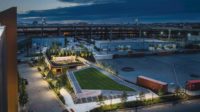A Children's Learning Center in Uruguay Anchors a Community-Oriented Campus
La Barra, Uruguay

A mile inland from southeastern Uruguay’s Atlantic coast, in the Maldonado town of La Barra, a learning center for children aged 3 to 12 sits amid an evergreen forest. Dubbed la Flor and designed by Pedro Livni and Rafael Solano of livni+, and Diego Arraigada, the learning center forms an integral part of Portal Bosque, a nonprofit, all-ages cultural club conceived to foster creativity and community.
The idea for Portal Bosque arose during the pandemic, when more than 30 Argentinean entrepreneurs and their families resettled in Uruguay’s Punta del Este, a region popular for its seaside resorts and abundant cultural offerings—at least during the summer months of November to February. During the off-season, the émigré families found educational and recreational opportunities lacking, especially for school-age children. This prompted new residents Mariquel Waingarten and Matías Woloski to conceptualize Portal Bosque and its multidisciplinary programming that unites nature, technology, and the arts. Waingarten and Woloski planned the complex for an initial membership of 100 families, who pay dues for access to facilities including a café, a greenhouse for botanical exploration, and an outdoor biopool. Non-members may purchase tickets to theater performances, outdoor concerts, and other events.

La Flor’s translucent polycarbonate glows in low light. Photo © Marcos Guiponi, click to enlarge.
To realize their vision, the clients turned to Livni, based in Montevideo, Uruguay, and Arraigada, in Rosario, Argentina. As principals of three-to-five-person design firms that focus on residential and small-to-medium-scale institutional work, the men have much in common. In addition, both are educators who developed a rapport during contemporaneous teaching engagements at the Universidad Torcuato di Tella in Buenos Aires. (Arraigada still teaches there, while Livni is on the architecture faculty at the Universidad de la República in Montevideo.) So when the clients requested that Livni, who had been recommended to them, and Arraigada, who had previously designed Waingarten’s beachfront house, collaborate on Portal Bosque, the architects gladly agreed.
Together, Livni’s and Arraigada’s firms are responsible for Portal Bosque’s master plan and five of its seven pavilions, nestled throughout 15 acres of maritime pines. The campus layout respects much of what was already there; for example, the property’s well-trod walking paths were incorporated into it. As Arraigada notes, “It was a matter of finding the best opportunities for each building,” whether la Recepción (the Reception)—a preexisting mud-walled house transformed into a welcome center—or el Pez (the Fish), a concrete outdoor amphitheater that, from above, resembles a fish skeleton surfacing through a grassy slope.
Then there is la Flor (the Flower), the 3,200-square-foot children’s learning center that comprises a large square from which seven circular pods emerge, each housing a different program: fabrication lab, music room, library, arts-and-crafts studio, audiovisual space, kids’ restroom, and small kitchen plus restroom for teachers. These activity pods can be used simultaneously, accommodating 10 to 15 kids each, and approximately 50 people can gather in the square core to play or share experiences. A wood frame unifies the building, creating a minimalist structure that reads as a continuation of its natural surroundings. Inside, a smooth concrete floor offers a neutral baseline as muted teal seating and carpets complement the warm pine finishes. And while the main square’s clear glass envelope allows visual connection with the forest, the pods’ translucent polycarbonate skins focus attention inward.

1
The activity pods focus attention inward (1 & 2). Photos © Marcos Guiponi

2
That the learning center’s plan evokes a flower is incidental; rather, the architects emphasize their design’s affinity with the 1960s experiments of the Japanese Metabolists. Livni explains: “Like a Metabolist work, the learning center has a designated core—the square—and circular plug-ins, which carry specific programs.” This co-mingling of geometries, with the curvilinear softening the hard-edged, creates a more organic feel, heightened as one approaches via the meandering stone path. Livni and Arraigada adopted a similar core/plug-in strategy for other pavilions on the property, including a culinary space named el Comedor (the Dining Room) and an indoor theater called la Nave (the Ship), both nearing completion.
Portal Bosque opened in November 2023. Just a few months later, membership is at capacity—an evident endorsement by the families for which the club was conceived. With its educational and cultural offerings for all ages, Portal Bosque has become the place for creativity and community its cofounders envisioned. And the learning center, with its honest materials, striking geometries, and kinship with nature, plays a decisive role in Portal Bosque’s success.
Click drawing to enlarge

Credits
Architects:
Diego Arraigada Arquitectos (Argentina) — Diego Arraigada, principal; Francisco Falabella, project manager; Sofía Rothman, Nicolás Alvarez Saby, Paula Pasquinelli, Manuel Ventura, design team.
livni+ (Uruguay) — Pedro Livni, principal; Rafael Solano Ferrari, associate architect; Diamela Meyer, Serrana Lluch, Valentin Eyheralde, design team; Lorenzo Preve, construction coordination
Engineers:
Magnone Pollio (structural); Estudio Hofstadter (structural, lighting); Dica & Asociados (sanitary); Asuan (conditioning)
Consultants:
Angeles Casares, Chris Storey (landscape); Marcelo Ribeiro, Koko Dominguez, Den Rey, Didi, Estudio Croma, Male Traynor (interior design)
General Contractor:
SURESTE Construcciones
Client:
Fundación Portal Bosque
Size:
3,230 square feet
Cost:
$350,000
Completion Date:
November 2023
Sources
Polycarbonate:
Abasur



